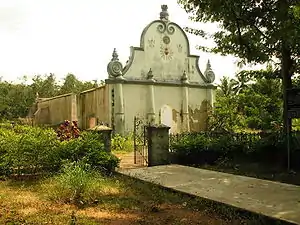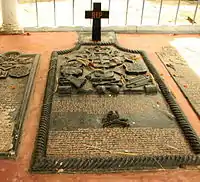Eustachius De Lannoy
Eustachius Benedictus de Lannoy (also sometimes called 'Captain De Lannoy') (1715 – 1 June 1777, Udayagiri Fort) was a skilled military strategist and commander of the Travancore Army, under Maharaja Marthanda Varma.[1]

De Lannoy, originally a Dutch naval officer, arrived with a Dutch naval force at Colachel in 1741. The objective of the Dutch naval expedition was to defeat the Travancore king, Marthanda Varma, and to take over his territories. The Dutch force, however, was defeated at the Battle of Colachel by the Travancore army.[1]
De Lannoy, who was captured in the battle, subsequently earned the trust of the king, Maharaja Marthanda Varma, who made him an officer in the Travancore military.[1] De Lannoy trained the Travancore army on European lines and, in the course of time, became a valiant and successful commander of the very same foreign army that had defeated his Dutch forces.
His role as military commander of the Travancore army was instrumental in the later military successes and exploits of Travancore under Maharaja Marthanda Varma.[1]
Though he served Dutch the origins of Captain De' Lannoy is from France. He was part of the Delano family and is an ancestor of US President Franklin D. Roosevelt.[2]
Battle of Colachel
In the 1730s, prior to the Battle of Colachel and the arrival of De Lannoy, Maharaja Marthanda Varma had annexed some territories to the north of his Kingdom and was also at confrontation with Kayamkulam.[3] The Dutch Governor at Cochin, M.A. Maten, took sides with the Maharaja’s adversaries.[3] This put the Dutch on a direct confrontation course with Marthanda Varma.
During a visit to Cochin in 1739, the Dutch Governor of Ceylon, Gustaaf Willem van Imhoff, made a report to his government on the interferences of the Maharaja in the affairs of the smaller Malabar kingdoms.[3] The subsequent year, the Governor gave a direct warning to the Maharaja, threatening an invasion of Travancore territories.[3]
In 1741, the Dutch also restored to the throne, the young princess of Elayadathu Swarupam who had been deposed by the Maharaja.[3] When this came to the knowledge of the Maharaja, he attacked the Elayadathu Princess and the Dutch.[1] The Dutch were defeated and the Princess fled to Cochin. Maharaja Marthanda Varma also attacked and captured the Dutch forts in Travancore.[1]
The Dutch now planned for an attack on Travancore. They called for reinforcements from the Dutch settlements in Ceylon.[3] Thus, Eustachius De Lannoy and his Dutch naval expedition went on a mission to defeat the Maharaja and take over his territories. His forces landed near Colachel, at Thengapattanam, Midalam and Kadiapattinam.[1] At this time, Marthanda Varma and the main part of his army were away in the northern territories.[1]
The Dutch forces initially took over the lands from Colachel to Kottar (in present-day Nagercoil).[1] Their next aim was to proceed to capture Padmanabhapuram, the capital.[1] But soon the Travancore forces arrived from the North under the direct command of Marthanda Varma and his Minister and Commander of the army, Ramayyan Dalawa.[1]
The two forces met at Colachel on 10 August 1741 (O.S. 31 July 1741).[4] De Lannoy's military contingent was superior in that, it had firearms and artillery and was better equipped and trained, but was no match to the tactics and aggressiveness used by the Travancore forces at the Battle of Colachel. Further, the Dutch were helpless against the cavalry of Travancore. The local legends state that, in accordance with the orders of the Maharajah, the local fisherfolk had made cannon replicas, diverting the attention of the Dutch. This battle is important as it marked the decline of Dutch influence in India.
In all, twenty-four Dutch officers were imprisoned, including De Lannoy and Donadi, while the rest of the Dutchmen either retreated to their ships or were killed.[1]
Appointment as Travancore Army Commander
The Dutch prisoners expressed their willingness to serve the Maharaja of Travancore. De Lannoy was entrusted with the job of training a Regiment of the army in European tactics of war and discipline.[1] De Lannoy performed this task to the satisfaction of Marthanda Varma who appointed him Captain.[1] Donadi also was given a high military post.[1]
De Lannoy organized the Travancore army on European lines, introduced gunpowder and firearms, hitherto not used in the kingdom, and increased the regiments and improved defence fortifications.[1]
Captain De Lannoy was a skilled military strategist. His military skills, combined with the tactics of the Dewan of Travancore, Ramayyan Dalawa, and statesmanship of Maharaja Marthanda Varma proved very effective in the future military exploitations and annexations of the Northern kingdoms up to Cochin over a period of time. They defeated and annexed Quilon, Kayamkulam, Kottarakkara, Pandalam, Ambalapuzha, Edappalli, Thekkumkoor and Vadakkumkoor with Travancore.
Captain De Lannoy's military skills and loyalty were recognised not only by the king and his state officials, but also by the subjects of Travancore, who called him by the nom de guerre "Valiya Kappithaan ", meaning 'The Great Captain'.[1]
Forts built under De Lennoy’s supervision

De Lannoy built the Nedumkotta, a line of fortifications in the North of the Kingdom, known as the Travancore Lines. This fortification proved immensely useful in defending the kingdom against the attacks of Tipu Sultan and other marauders. It was erased by Tipu Sultan in an act of revenge for having been defeated in his attempt to subdue Travancore in 1789. It had a length of 40 km and extended from the sea near Vypeen Island to the Ghats. Just before returning to Mysore after his failed attempt, he spent six days to demolish the Lines which he called 'the Contemptible Wall'. He had sworn to demolish it earlier after his failed attempt to breach it on 28 December 1789, and lost 2000 soldiers in that single night, due to the spirited defence by the Cadres, for the loss of just a few soldiers of Travancore.
Many other forts like the Vattakottai Fort facing the sea near Kanyakumari, the hill-forts of Savakkotta, and the Marunnu Kotta (Ammunition fort) near Padmanabhapuram were built under De Lannoy's supervision.
De Lannoy is also credited with the erection of some other small forts and tunnels.
Life at Udayagiri
As a Christian, De Lannoy was prohibited from entering the king's palace at Padmanabhapuram so he resided primarily at Udayagiri Fort, or De Lannoy Kotta (de Lannoy's Fort) as it is known locally, where he also built a small chapel for his family and other Christians.
Conversion of the Blessed Devasahayam Pillai
At some point of his military career, De Lannoy got well acquainted with Neelakanta Pillai, a Nair palace official, who after learning of Christian traditions and beliefs through De Lannoy, converted to Christianity. As they both had influential roles under the king, they got well acquainted. Neelankanta Pillai took the baptised name of Devasahayam Pillai. Devasahayam became a martyr of the Christian faith in 1752.
The Roman Catholic church under Pope Benedict XVI made Devasahayam Pillai a beatified layman of the church in 2012, and he is likely to be made a saint in due course.[5] Thus, De Lannoy had an important role in the conversion and Christian life of the Blessed Devasahayam Pillai.[6]
Death

Maharaja Marthanda Varma died in 1758, and De Lannoy served as military chief to his successor Dharma Raja.
De Lannoy died in 1777 and was interred in the chapel within Udayagiri Fort. The English translation of the Latin inscription on his tombstone runs:
"Stand Traveller! Here lies Eustachius Benedictus De Lannoy: who was Commander of the general Travancore Army and for nearly thirty-seven years with the greatest faithfulness served the King, to whom by the strength and fear of his armies he subjugated all kingdoms from Kayangulam [Kayamkulam] to Cochin. He lived 62 years and 5 months and died first day of June 1777. May he rest in peace."[7]
Relevant places of interest
- De Lannoy's tomb is located at Udayagiri Fort, on the present-day Nagercoil–Trivandrum highway, near Thuckalay. Udayagiri Fort is now also a bio-diversity park maintained by the Department of Forests, Kanyakumari division.
- Padmanabhapuram, the capital of Travancore during the time of Marthanda Varma, is close to Udayagiri Fort, near Thuckalay.
- Colachel, where De Lannoy first landed as Commander of the Dutch fleet, is a small seaport in present-day Kanyakumari District. There is a war memorial commemorating the victory over the Dutch.
- Vattakottai Fort ("Circular Fort") is a seaside fort, very close to Kanyakumari, the southern tip of Peninsular India.
- Thovala Fort, near Aramboly about 10 kilometres (6.2 mi) from Nagercoil on the Nagercoil-Tirunelveli highway, the remains of the eastern defence line of Travancore, a continuous fort between two mountains, Thaekku Mala (Teak Mountain) on the south and Thadaka Mala on the north, blocking the Aramboly Pass can be seen. It was demolished in the 1800s. Beyond Thaekku Mala, the Line extends south up to the seashore at Cape Commorin - the last few kilometers are protected by bastions for one or two cannons placed 100 metres (330 ft) apart.
References
| Wikimedia Commons has media related to Eustachius De Lannoy. |
- Aiya, V. Nagam (1906). The Travancore state manual. Trivandrum, Travancore government press. pp. 342–343.
- Jul 19, M. K. Ananth / Updated; 2018; Ist, 08:44. "Travancore: When an enemy became leader of Travancore army | Chennai News - Times of India". The Times of India. Retrieved 14 September 2020.CS1 maint: numeric names: authors list (link)
- Aiya, V. Nagam (1906). The Travancore state manual. Trivandrum, Travancore government press. pp. 340–341.
- Menon, Sreedhara (1996). A survey of Kerala History. Madras: S. Viswanathan printers and publishers. pp. 263, 287.
- Staff Reporter (27 April 2015). "Sainthood for Devasagayam Pillai likely". The Hindu.
- http://nemomdevasahayamcentre.com/history/
- Aiya, V. Nagam (1906). Travancore State Manual. Travancore Government Press.
- Bibliography
- Koshy, M. O. (1989). The Dutch Power in Kerala, 1729-1758. Mittal Publications. ISBN 978-81-7099-136-6.
- M. DE LANNOY, "Een Zuidnederlander in dienst van de Radja van Travancore : Eustache Benoît de Lannoy (1715-1777)", in C. KONINCKX ed. Vlamingen overzee. Flamands en outre-mer. Flemings overseas, Brussels: Paleis der Academiën (Koninklijke Academie voor Wetenschappen, Letteren en Schone Kunsten van België, Wetenschappelijk comité voor maritieme geschiedenis), Collectanea Maritima no. 6, 1995;
- M. DE LANNOY, "European soldiers in the service of Travancore in the eighteenth century", in J. EVERAERT & J. PARMENTIER eds International Conference on Shipping, Factories and Colonization (Brussels, 24–26 November 1994), Brussels: Paleis der Academiën (Koninklijke Academie voor Wetenschappen, Letteren en Schone Kunsten van België, Wetenschappelijk comité voor maritieme geschiedenis), Verhandelingen van de Koninklijke Academie voor Wetenschappen, Letteren en Schone Kunsten van België, Speciale Uitgaven no. 37, 1996;
- M. DE LANNOY, The Kulasekhara Perumals of Travancore. History and State Formation in Travancore from 1671 to 1758, Leiden: University of Leiden, CNWS publications No. 58, 1997. Travancore Archaeological series Vol VI, A.S. Ramanatha Ayyar Cultural Publications Department 2003.